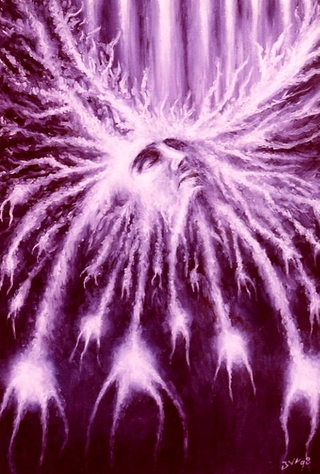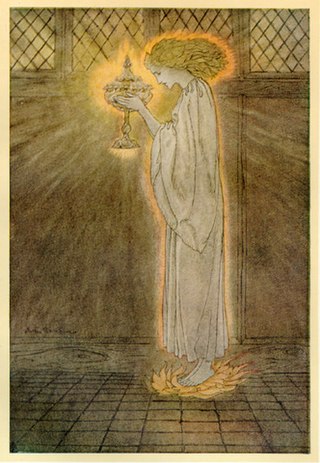Related Research Articles

A subtle body is a "quasi material" aspect of the human body, being neither solely physical nor solely spiritual, according to various esoteric, occult, and mystical teachings. This contrasts with the mind–body dualism that has dominated Western thought. The subtle body is important in the Taoism of China and Dharmic religions such as Hinduism, Buddhism, and Jainism, mainly in the branches which focus on tantra and yoga, where it is known as the Sūkṣma-śarīra. However, while mostly associated with Asian cultures, non-dualistic approaches to the mind and body are found in many parts of the world.

The astral body is a subtle body posited by many philosophers, intermediate between the intelligent soul and the mental body, composed of a subtle material. In many recensions the concept ultimately derives from the philosophy of Plato though the same or similar ideas have existed all over the world well before Plato's time: it is related to an astral plane, which consists of the planetary heavens of astrology. The term was adopted by nineteenth-century Theosophists and neo-Rosicrucians.
In esoteric cosmology, a plane is conceived as a subtle state, level, or region of reality, each plane corresponding to some type, kind, or category of being.
Paramatman or Paramātmā is the Absolute Atman, or supreme Self, in various philosophies such as the Vedanta and Yoga schools in Hindu theology, as well as other Indian religions like Sikhism. Paramatman is the "Primordial Self" or the "Self Beyond" who is spiritually identical with the absolute and ultimate reality. Selflessness is the attribute of Paramatman, where all personality/individuality vanishes.
The mental body is one of the subtle bodies in esoteric philosophies, in some religious teachings and in New Age thought. It is understood as a sort of body made up of thoughts, just as the emotional body consists of emotions and the physical body is made up of matter. In occult understanding, thoughts are not just subjective qualia, but have an existence apart from the associated physical organ, the brain.

In neo-Theosophy, the etheric body, ether-body, or æther body is the subtle body propounded in esoteric philosophies as the first or lowest layer in the human energy field or aura. The etheric body is said to be in immediate contact with the physical body and to sustain it and connect it with "higher" bodies. It is also said to consist of a finer substance, more pure and composed of smaller particles, than the ordinary matter of the physical plane.
The etheric plane is a term introduced into Theosophy by Charles Webster Leadbeater and Annie Besant to represent the subtle part of the lower plane of existence. It represents the fourth [higher] subplane of the physical plane, the lower three being the states of solid, liquid, and gaseous matter. The idea was later used by authors such as Alice Bailey, Rudolf Steiner, Walter John Kilner and others.
A kosha, usually rendered "sheath", is a covering of the Atman, or Self according to Vedantic philosophy. There are five koshas, and they are often visualised as the layers of an onion in the subtle body. The Tvam ("Thou") padartha of the MahavakyaTat Tvam Asi is determined by the analysis of Panchakoshas that are not the atman. Panchakoshas are discussed in the Brahmanandavalli Chapter of Taittiriya Upanishad which is a part of the Taittiriya Samhita of the Krishna Yajur Veda and in which particular chapter is discussed ways and means to achieve Brahman. It gives a detailed description of the dimensions of human personality or the dimensions of the Self.

Neo-Theosophy is a term, originally derogatory, used by the followers of Helena Blavatsky to denominate the system of Theosophical ideas expounded by Annie Besant and Charles Webster Leadbeater following the death of Madame Blavatsky in 1891. This material differed in major respects from Blavatsky's original presentation, but it is accepted as genuinely Theosophical by many Theosophists around the world.
Causal plane is a term used in Neo-Theosophy, some contemporary Vedanta, the New Age,, and sometimes Occultism, to describe a high spiritual plane of existence. However, there is great variation between the different definitions.
The Anandamaya kosha or "sheath made of bliss" (ananda) is in Vedantic philosophy the most subtle or spiritual of the five levels of embodied self. It has been interpreted differently according to specific schools of Indian thought.

Ernest Egerton Wood was a noted English yogi, theosophist, Sanskrit scholar, and author of numerous books, including Concentration – An Approach to Meditation, Yoga and The Pinnacle of Indian Thought (1967).

Sri Siddharameshwar Maharaj (1888–1936) was a guru in the Inchagiri Sampradaya founded by his guru Bhausaheb Maharaj, a branch of the Navnath Sampradaya, the 'Nine Masters' tradition in India. His disciples included Nath teachers Nisargadatta Maharaj, Ranjit Maharaj, Kaadsiddheshwar, and Ganapatrao Maharaj Kannur.

Antaḥkaraṇa is a concept in Hindu philosophy, referring to the totality of the mind, including the thinking faculty, the sense of I-ness, and the discriminating faculty. Antaḥ means 'inner' and karaṇa means 'instrument', or, 'function'. Therefore, the word Antaḥkaraṇa can be understood as 'inner organ', 'inner functions', or, 'inner instrument'.
Avyakta, meaning "not manifest", "devoid of form" etc., is the word ordinarily used to denote Prakrti on account of subtleness of its nature and is also used to denote Brahman, which is the subtlest of all and who by virtue of that subtlety is the ultimate support (asraya) of Prakrti. Avyakta as a category along with Mahat and Purusa plays an important role in the later Samkhya philosophy even though the Bhagavad Gita III.42 retaining the psychological categories altogether drops out the Mahat and the Avyakta (Unmanifest), the two objective categories.
According to Sarira Traya, the Doctrine of the Three bodies in Hinduism, the human being is composed of three shariras or "bodies" emanating from Brahman by avidya, "ignorance" or "nescience". They are often equated with the five koshas (sheaths), which cover the atman. The Three Bodies Doctrine is an essential doctrine in Indian philosophy and religion, especially Yoga, Advaita Vedanta, Tantra and Shaivism.
Chidabhasa is the Sanskrit term which means the abhasa or reflection of Brahman, the Universal Self, on or through the mind; ordinarily this term is used to denote the reflected Universal Self in the Jiva, the Individual Self. The philosophical conditionedness belongs to chidabhasa. The causal body or the Karana Sarira which is the cause of man’s enjoyment or suffering is composed of the Anandamaya Kosha and adheres to the soul so long as the soul resides in the Sthula Sarira or the Sukshama Sarira, both vehicles of Avidya ('ignorance'); afflicted by vasanas ('desires/longings') the ordinary being does not become Chidabhasa, the reflection of the Atman in the Karana Sarira.
Abhimāna (Sanskrit:अभिमान) variously means – pride, false prestige, desire, an impression, the conception, by self-conception, from the misconception; in Hindu philosophy, it means – prideful attachment of "I-sense" i.e. man + māna ; it also means – identify or identification and also refers to selfish conviction, for abhimāna is the function of ahamkara (ego) as the state of mind which interprets experience as " mine ".

Theosophy is a religion established in the United States during the late 19th century. It was founded primarily by the Russian Helena Blavatsky and draws its teachings predominantly from Blavatsky's writings. Categorized by scholars of religion as both a new religious movement and as part of the occultist stream of Western esotericism, it draws upon both older European philosophies such as Neoplatonism and Indian originated religions such as Hinduism and Buddhism.

Hinduism is regarded by modern Theosophy as one of the main sources of "esoteric wisdom" of the East. The Theosophical Society was created in a hope that Asian philosophical-religious ideas "could be integrated into a grand religious synthesis." Prof. Antoine Faivre wrote that "by its content and its inspiration" the Theosophical Society is greatly dependent on Eastern traditions, "especially Hindu; in this, it well reflects the cultural climate in which it was born." A Russian Indologist Alexander Senkevich noted that the concept of Helena Blavatsky's Theosophy was based on Hinduism. According to Encyclopedia of Hinduism, "Theosophy is basically a Western esoteric teaching, but it resonated with Hinduism at a variety of points."
References
- ↑ Sharma 2006, p. 193.
- 1 2 Bahder & Bahder 2013.
- 1 2 Siddharameshwar Maharaj 2009, pp. 31–32.
- 1 2 Ranade 1926, p. 155–168.
- ↑ Samael Aun Weor. "Man and the Universe That Surrounds Him". Archived from the original on 2007-09-27. Retrieved 2007-03-25.